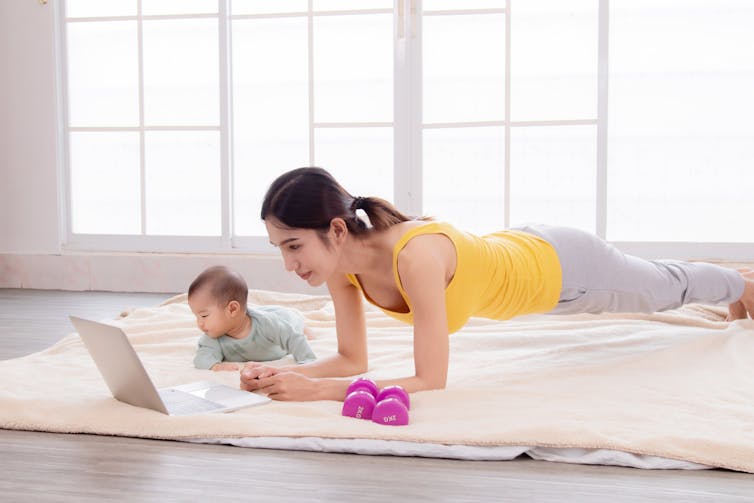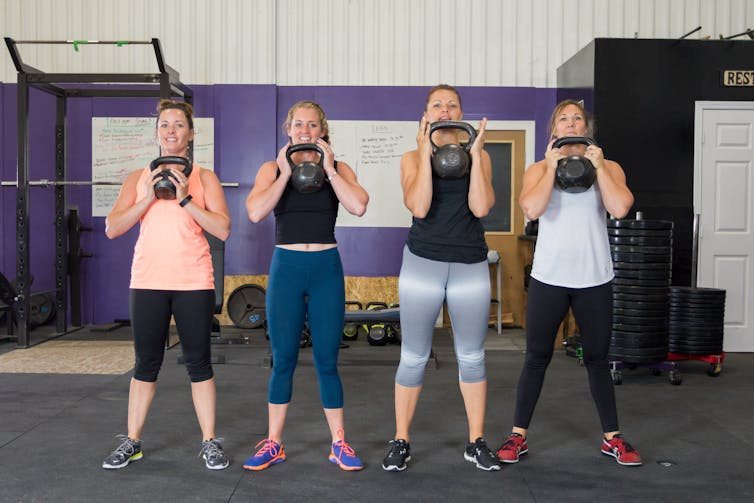As a society, we can do better to support postpartum women’s physical activity engagement, writes Iris Lesser, and Carl Nienhuis, from University of The Fraser Valley; and Corliss Bean, and Talia Ritondo, from Brock University, in this article republished from The Conversation.
The birth of a child is a momentous occasion in a woman’s life. It may also be one of the most challenging transitions that women face, requiring adaptation to identity and role while undergoing a unique physiological transformation.
Physical activity after recovery from birth can be helpful. Women who engage in postpartum exercise tend to have better mental and physical health outcomes. Benefits of exercise for new moms include weight loss, improved aerobic fitness, improved mood and increased social connectedness. However, physical activity rates tend to drastically decline after pregnancy.
Despite the potential positive impact that physical activity may have during the postnatal transition, little academic attention has been given to helping women return to exercise after the birth of a child. As an interdisciplinary research team in sport and physical activity, we have been working to address this gap by exploring women’s postnatal physical activity experiences.
Women’s questions about postpartum exercise
We asked women what questions they had about physical activity engagement within their first three months postpartum. What they shared about their physical activity engagement parallels what has been identified in research: mothers’ physical activity is reduced with the birth of a child, and primary barriers to engagement include a lack of opportunity.

Women’s questions were fuelled by feelings of uncertainty and confusion about their return to physical activity, asking: How much physical activity should I do? What intensity of exercise is safe for me? What type of physical activity should I engage in? How do I engage in physical activity with my newborn? How will I know if I’ve pushed my body too hard?
The American College of Obstetrics and Gynecology states that women should slowly return to physical activity after giving birth and work their way up to the general physical activity guidelines of 150 minutes of moderate to vigorous aerobic physical activity per week. If women have had a surgical birth or tearing during a vaginal birth which required stitches, it may take longer to become active.
Most women were curious about strategies and recommendations for physical activity after the birth of a child, including finding the time, energy and motivation to exercise.
Based on these frequently asked questions, we provide recommendations for supporting women in engaging in postpartum physical activity for two relevant groups:
- physicians and health-care workers;
- community leisure service providers (such as recreation programmers and fitness instructors).
Since both groups are actively invested in improving community health and well-being, we hope to outline how they can work together to provide accessible, equitable and meaningful physical activity opportunities for postnatal women.
Physicians and health-care workers
In Canada, the most common health-care experience for new mothers is a six-week followup with their physician or midwife. At this point mothers are told they can return to physical activity if their body has healed appropriately. Unfortunately, most women feel this support is inadequate, stating a need for more information from health-care professionals about guidelines for returning to physical activity.

So, how can physicians and health-care workers better assist these women? Women outlined how best to help them return to physical activity. Since all women do not experience childbirth and recovery the same way, opportunities for equitable and individualized care for postpartum women are essential. This means offering not only extended care beyond the six-week mark, but tailoring care for each woman’s recovery process and physical activity engagement.
Specifically, there is a need for physical activity education by midwives, physical activity counsellors or physicians. Women also recommended that access to a pelvic physiotherapist be a standard part of postnatal care.
It’s important to assess the pelvic floor after childbirth. It is a crucial group of muscles that helps maintain bladder and bowel control, supports internal organs and co-ordinates with the deep core, diaphragm and deep back muscles. These muscles do a lot of the heavy lifting during pregnancy and can be strained during childbirth, requiring rehabilitation.
Additional resources would be valuable to give women tools to develop confidence to return to physical activity. These include safe exercise choices and progressions during the postpartum period; nutrition, hydration and sleep guidelines; exercises that can be done with an infant; and information about child-friendly exercise spaces.
Such information could be packaged in multiple formats — such as pamphlet, website and phone app — and offered as part of the standard package when women are discharged from the hospital following delivery, or at a six-week physician followup.
Community leisure service providers
Women in our studies also desired more informational support to join local fitness and community centres. Such involvement meant the chance to meet other mothers and learn more about safe physical activity engagement postpartum. Yet, accessing these programs was often fraught with barriers.
In a study to be published in Health and Fitness Journal of Canada, we found postnatal women wished for individualized and affordable community programming, given the high costs of caring for a newborn. In interviews with mothers after a group exercise program, we found this form of programming to increase community connection, motivation and accountability.
Mothers also said that flexible childcare and attendance options — such as a combination of daycare facilities, classes that accommodate infants and online fitness classes — would support engagement.
Lastly, women spoke about how mothering social groups, resource-sharing between programmers and health-care providers, and maternity consultants for staff can help increase postnatal programming quality, and in turn, participation.
As a society, we can do better to support postpartum women’s physical activity engagement. When women are physically active, they feel physically and mentally well, enabling them to better handle the challenges of motherhood and be positive health role models for their children.
If you are interested in participating in a research study to better understand the experiences of mothers postpartum, please visit this page.
Iris Lesser, Assistant professor in kinesiology, University of The Fraser Valley; Carl Nienhuis, Assistant Professor, Kinesiology, University of The Fraser Valley; Corliss Bean, Assistant Professor of Recreation & Leisure Studies, Brock University, and Talia Ritondo, Gender & Sexual Violence Education Coordinator, Brock University
This article is republished from The Conversation under a Creative Commons license. Read the original article.


